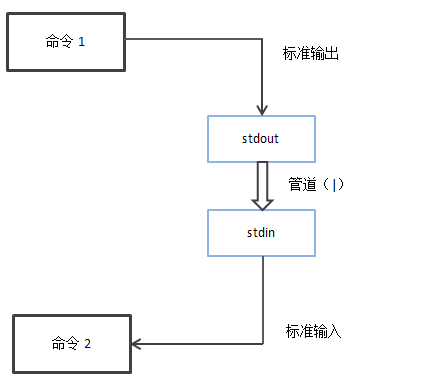Linux pipe command outline
What is a pipeline command? Judging from the name, it should be divided into 'pipeline' and 'command'.
pipeline
Let's look at pipelines first. This is how I understand pipelines. Pipelines are used to establish a connection between two commands, that is, the standard output of the previous command is the standard input of the next command. This process is achieved through pipelines.

The pipe uses the symbol '|'. It should be noted that the pipe processes the standard output of the previous command. The standard error output of the previous command will be ignored. In other words, the output information of the previous command that is executed correctly will be used as the input of the next command. If the previous command is executed incorrectly, the error information printed will not be used as the input of the next command. This is the role of the pipe, see the following example:
# ls –a /etc | grep ^s
This example is used to search for files in /etc that begin with s. The results of searching for files in /etc are piped as the standard input of the grep command.
Order
After talking about pipes, let's look at commands. The commands mentioned here are mainly for the commands following the pipe (|). As we said above, the function of the pipe is to use the standard output of the previous command as the standard input (stdin) of the next command, so the next command is required to be able to read data from the standard input device. So not all commands supported by the Linux system can be used as pipe commands.
Like the case introduced in this article, we cannot use the cp command directly after the pipeline. The following command is wrong:
# find /a –name login* | cp –t /b //Error
Because cp is not a pipe command, it cannot accept data from standard input (stdin).
The commands that accept data from standard input are:
Sorting statistics commands: sort , uniq , wc
Bidirectional redirection: tee
Character conversion commands: tr , col , join , paste , expand
Split command: split
Parameter substitution: xargs
The above commands are pipeline commands that can accept data from standard input. I will not introduce these commands in this article. I will introduce the usage of these commands in subsequent articles.
Summarize
Here is a summary of the pipeline commands:
1. The pipeline command will only process standard output and ignore standard error output
2. The pipeline command must be able to accept the data from the previous command as standard input and continue processing.
This is the end of the introduction to the concept of pipeline commands. I hope this article will be helpful to you.
For reprinting, please send an email to 1244347461@qq.com for approval. After obtaining the author's consent, kindly include the source as a link.
Related Articles
Restart PostgreSQL in Ubuntu 18.04
Publish Date:2025/04/09 Views:72 Category:PostgreSQL
-
This short article shows how to restart PostgreSQL in Ubuntu. Restart PostgreSQL Server in Ubuntu You can restart Postgres server in Ubuntu using the following command. Order: sudo service postgres restart Sometimes the above command does n
Issues to note when installing Apache on Linux
Publish Date:2025/04/08 Views:78 Category:OPERATING SYSTEM
-
As the most commonly used web server, Apache can be used in most computer operating systems. As a free and open source Unix-like operating system, Linux and Apache are a golden pair. This article will introduce the installation and use of A
How to decompress x.tar.xz format files under Linux
Publish Date:2025/04/08 Views:186 Category:OPERATING SYSTEM
-
A lot of software found today is in the tar.xz format, which is a lossless data compression file format that uses the LZMA compression algorithm. Like gzip and bzip2, it supports multiple file compression, but the convention is not to compr
Summary of vim common commands
Publish Date:2025/04/08 Views:115 Category:OPERATING SYSTEM
-
In Linux, the best editor should be vim. However, the complex commands behind vim's powerful functions also make us daunted. Of course, these commands do not need to be memorized by rote. As long as you practice using vim more, you can reme
Detailed explanation of command return value $? in Linux
Publish Date:2025/04/08 Views:58 Category:OPERATING SYSTEM
-
? is a special variable. This variable represents the return value of the previous command. That is to say, when we run certain commands, these commands will return a code after running. Generally, if the command is successfully run, the re
Common judgment formulas for Linux script shell
Publish Date:2025/04/08 Views:159 Category:OPERATING SYSTEM
-
In shell script programming, predicates are often used. There are two ways to use predicates, one is to use test, and the other is to use []. Let's take a look at how to use these two methods through two simple examples. Example 1 # test –
Shell script programming practice - specify a directory to delete files
Publish Date:2025/04/08 Views:98 Category:OPERATING SYSTEM
-
Usually, in Linux system we need to frequently delete some temporary files or junk files. If we delete them one by one manually, it will be quite troublesome. I have also been learning shell script programming recently, so I tried to write
Use of Linux command at - set time to execute command only once
Publish Date:2025/04/08 Views:158 Category:OPERATING SYSTEM
-
This article mainly involves a knowledge point, which is the atd service. Similar to this service is the crond service. The functions of these two services can be similar to the two functional functions of javascript. Those who have learned
Use of Linux command crontab - loop execution of set commands
Publish Date:2025/04/08 Views:170 Category:OPERATING SYSTEM
-
Compared with at , which executes a command only once, crontab, which we are going to talk about in this article, executes the set commands in a loop. Similarly, the use of crontab requires the support of the crond service. The service is s

